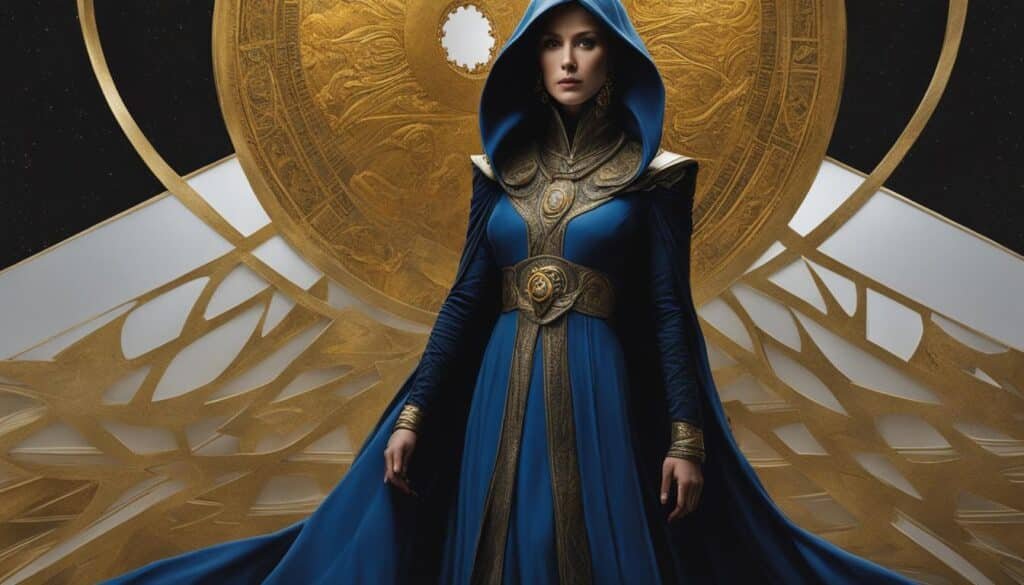Denis Villeneuve’s highly anticipated adaptation of Frank Herbert’s Dune series is set to take the sci-fi genre by storm. With meticulous attention to detail and a commitment to authenticity, Villeneuve aims to bring Herbert’s visionary universe to life on the silver screen. Moviegoers can expect a visually stunning and immersive cinematic experience that faithfully captures the essence of Frank Herbert’s intricate storytelling.
Key Takeaways: Denis Villeneuve’s Dune Series
- Denis Villeneuve’s adaptation of Frank Herbert’s Dune series aims to stay true to the source material.
- The film promises a visually stunning and immersive experience for audiences.
- Denis Villeneuve’s attention to detail ensures the grandeur and complexity of Herbert’s universe will be showcased on screen.
- This adaptation strives to capture Frank Herbert’s vision and deliver a faithful cinematic journey for fans.
- Denis Villeneuve’s Dune Series is highly anticipated and expected to redefine the sci-fi genre.
The Challenges of Adapting Dune to the Screen
Adapting Frank Herbert’s Dune to the screen has proven to be a formidable task for directors and producers over the years. The complex narrative and vast universe created by Herbert present unique challenges that require careful navigation to capture the essence of the story.
Two previous attempts at adaptation, David Lynch’s 1984 film and John Harrison’s 2000 miniseries, tackled the intricacies of Dune but with mixed results. Lynch’s film aimed to incorporate elements directly from the novel, while Harrison’s miniseries explored the political and religious themes in greater detail. However, both adaptations faced limitations in fully translating Herbert’s vision to the screen.
“Adapting a sprawling epic like Dune is a monumental undertaking. It requires balancing the intricacies of the source material with the creative decisions necessary for cinematic storytelling.” – Director Denis Villeneuve
Denis Villeneuve’s take on Frank Herbert’s Dune promises to deliver a faithful adaptation while offering a fresh perspective on the beloved story. With his impeccable directorial skills, Villeneuve aims to stay true to the source material’s depth and complexity, while taking advantage of the cinematic medium’s visual and narrative possibilities.
Villeneuve’s adaptation recognizes the challenges of previous attempts and strives to overcome them by staying faithful to Herbert’s original vision. Through meticulous attention to detail and a deep understanding of the source material, Villeneuve and his team ensure that the adaptation captures the essence of Dune while presenting it in a way that resonates with both longtime fans and newcomers alike.
Differences Between Villeneuve’s Adaptation and Previous attempts:
| Lynch’s Dune (1984) | Harrison’s Dune Miniseries (2000) | Villeneuve’s Adaptation |
|---|---|---|
| Deviated from Herbert’s visual style | Introduced changes to the original storyline | Provides a faithful representation of Herbert’s universe |
| Modified narrative choices | Intensified political and religious themes | Offers a fresh perspective while staying true to the source material |
| Altered key elements and concepts | Highlighted the Bene Gesserit sisterhood | Preserves the intricate world-building and character development |
Herbert’s Original Screenplay Adaptation

In his pursuit of bringing his novel “Dune” to the big screen, Frank Herbert himself ventured into the world of screenplay adaptation. His screenplay, totaling over 300 pages, explored a two-part film experience that closely followed the story of Paul Atreides and his epic battle against the Emperor. Unlike Denis Villeneuve’s adaptation, which splits the story into multiple films, Herbert’s screenplay aimed to capture the entire saga in a cohesive narrative.
“Dune is a heroic-adventure story set in the far future. … In many respects Dune is an existentialist novel, meaning that it sets forth a concept or system of concepts by which man can view himself in relation to the universe in which he lives. Man is not cast adrift in the universe; he is not on an objective-basis, logically left to the random convulsions of the marketplace or the being of the moment. … Man has a purpose higher than himself, and he can be responsible to that awareness.”[1]
While Herbert’s screenplay introduced essential characters and concepts, it lacked the visual storytelling elements that Villeneuve’s adaptation brings to life. The marriage of breathtaking visuals, intricate cinematography, and special effects in Villeneuve’s rendition allows audiences to fully immerse themselves into the rich and complex world of “Dune”.
Frank Herbert’s screenplay adaptation provided a foundation for future cinematic interpretations of “Dune”. Its exploration of the story’s expansive universe served as a testament to the depth and complexity inherent in Herbert’s original novel.
[1] Frank Herbert, “THE ORIGINAL *DUNE* SCREENPLAY” (unpublished manuscript), 1968.
Faithfulness to the Source Material – Lynch’s Dune

When discussing film adaptations of Frank Herbert’s Dune, David Lynch’s 1984 version holds a prominent place in the conversation. Lynch’s interpretation aimed to stay faithful to the source material by incorporating dialogue and scenes directly from the novel.
However, despite this commitment to faithfulness, Lynch’s Dune deviated from Herbert’s original vision in terms of visual style and narrative choices. Notable changes were made, including the introduction of weirding modules and the omission of inner monologues, altering the overall tone and atmosphere of the story.
“The movie was a frustrating failure because I tried to do something very delicate. The structure of the story needs this three-hour version, but the American film business just would not support it.” – David Lynch
While Lynch’s adaptation captured certain aspects of the book, it fell short in fully realizing Herbert’s intricate universe. The film’s distinct visual style, marked by an abundance of surreal and grotesque imagery, diverged from the original novel’s more subtle and nuanced portrayal of the characters and settings.
Ultimately, David Lynch’s Dune stands as a unique interpretation of the source material, showcasing the director’s artistic vision while adhering to some elements of the novel. However, its departure from Herbert’s original intent demonstrates the challenges inherent in bringing such a complex and expansive work to the silver screen.
Dune Comparison Table
| Adaptation | Faithfulness to Source Material | Visual Style | Narrative Choices |
|---|---|---|---|
| David Lynch’s Dune | Partial | Distinct and surreal | Altered, introduced weirding modules, omitted inner monologues |
| John Harrison’s Dune Miniseries | Partial | Faithful to political and religious themes | Added waterfall scene not in the original story |
| Denis Villeneuve’s Dune: Part One | To be determined | Visually stunning and immersive | Remains to be seen |
Faithfulness to the Source Material – Harrison’s Dune Miniseries

John Harrison’s 2000 miniseries adaptation of Dune aimed to stay faithful to the political and religious themes of the novel. The miniseries delved into the intricate power dynamics and featured the mysterious Bene Gesserit sisterhood more prominently. While it remained true to certain aspects of the book, the miniseries also made changes, such as the depiction of Paul’s ability to summon a waterfall, which was not present in the original story.
The miniseries, directed by John Harrison, strived to capture the essence of Frank Herbert’s political and religious exploration. It successfully emphasized the intricate power dynamics that drive the narrative and brought the mysterious Bene Gesserit sisterhood to the forefront. However, it also took certain creative liberties, introducing new elements like Paul’s ability to summon a waterfall.
Despite these alterations, the miniseries remained faithful to the core themes of the novel, showcasing the depth and complexity of Herbert’s source material. It provided an exciting visual interpretation of Dune while staying true to the essence of the story.
John Harrison’s Dune: A Faithful Adaptation
“We wanted to honor the legacy of Frank Herbert’s Dune while also bringing our own creative vision to the project. Our goal was to capture the political intrigue and religious themes that make Dune such a compelling work.”
– John Harrison, Director
The miniseries presented an opportunity to further explore the political dynamics at play within the world of Dune. By delving deeper into the complex power struggles between different factions and highlighting the influential role of the Bene Gesserit sisterhood, Harrison’s adaptation offered a fresh perspective on the source material.
While some fans may have wished for a more direct adaptation that adhered closely to every aspect of the novel, the miniseries managed to strike a balance between remaining faithful and introducing new elements. Ultimately, the adaptation brought Herbert’s vision to life on the screen, preserving the essence of the story while adding its own unique interpretation.
| Aspect | John Harrison’s Dune Miniseries | Faithfulness to the Source Material |
|---|---|---|
| Political Dynamics | Explores the intricate power dynamics extensively. | Stays true to the political themes of the novel. |
| Bene Gesserit Sisterhood | Features the mysterious sisterhood prominently. | Highlights the importance of the Bene Gesserit in the novel. |
| Creative Liberties | Introduces new elements, such as Paul’s ability to summon a waterfall. | Deviates from the original story but retains the core themes. |
Overall, John Harrison’s Dune miniseries demonstrated a commitment to honoring the source material while presenting a visually captivating adaptation. It successfully captured the spirit of Herbert’s novel, showcasing the intricate politics and religious undertones that make Dune a beloved masterpiece.
Villeneuve’s Visual Spectacle – Dune: Part One

Denis Villeneuve’s highly anticipated film, Dune: Part One, is a breathtaking example of visual beauty and exquisite cinematography. Set on the desert planet Arrakis, the movie’s stunning visuals transport audiences to a world of majestic sand dunes and awe-inspiring landscapes.
Villeneuve’s meticulous attention to detail is evident in every frame, capturing the harsh yet captivating beauty of Arrakis. This commitment to authenticity in recreating Frank Herbert’s world is truly remarkble and adds to the immersive experience for viewers.
The cinematography of Dune: Part One showcases the vastness of the desert planet, emphasizing the sense of danger and mystery that lies within its vast expanses. The colors, lighting, and contrast further accentuate the visual grandeur, creating a feast for the eyes.
From the intricate costume and set designs to the breathtaking special effects, every aspect of the film’s visuals elevates the storytelling and immerses the audience in the rich and vibrant world of Dune. Villeneuve’s skillful direction brings Herbert’s vision to life in a way that is both awe-inspiring and true to the original source material.
As audiences watch Dune: Part One, they will be transported to Arrakis, experiencing the visual spectacle that Villeneuve has masterfully crafted. This film is a testament to the power of visual storytelling, captivating viewers and leaving them eagerly awaiting the next installment in Denis Villeneuve’s epic adaptation.
Paul Atreides – The Protagonist’s Journey

The central character of Paul Atreides embarks on a transformative journey that spans the vast expanse of Denis Villeneuve’s adaptation of Frank Herbert’s Dune series. As a young scion of House Atreides, Paul’s life takes an unforeseen turn when his family is tasked with overseeing the treacherous desert planet of Arrakis. It is here that Paul’s true destiny begins to unfurl.
Villeneuve’s direction delves deep into the intricate layers of Paul’s character, capturing the essence of his personal evolution against the backdrop of Arrakis’ harsh and unforgiving environment. From his initial steps on the golden sands to the heights of his prophesied destiny as the Kwisatz Haderach, Paul’s journey resonates with audiences as they witness the weight of civilizations resting on his young shoulders.
The anticipation surrounding Paul’s portrayal only heightens the intrigue of this pivotal character. Timothée Chalamet, known for his emotional depth and raw talent, brings Paul to life with a nuanced performance that captures the complexity and inner conflicts of the protagonist. Audiences eagerly await the unfolding of Paul’s destiny, anticipating how his choices will shape the fate of the universe.
As the protagonist’s journey unfolds, viewers are swept away by the immersive storytelling and the exploration of Paul’s identity and role in the larger narrative. Villeneuve’s cinematic vision artfully captures the essence of Paul’s transformative path, ensuring that audiences will be captivated by this compelling character as he navigates the intricate web of politics, religion, and power on Arrakis.
The Transformation of Paul Atreides
“I must not fear. Fear is the mind-killer. Fear is the little-death that brings total obliteration…” – Paul Atreides
The Legacy of Frank Herbert’s Literary Masterpiece
Frank Herbert’s original novel Dune, published in 1965, remains a timeless literary masterpiece. The novel delves into complex themes of power, religion, and ecology in a distant future. Denis Villeneuve faces the challenge of translating Herbert’s intricate universe into a visually stunning masterpiece that stays true to the depth and complexity of the source material.
The Intrigue of the Bene Gesserit

Within the political landscape of Dune, the mysterious and influential Bene Gesserit sisterhood plays a significant role. Villeneuve’s film delves into their intricate role within the power dynamics of Arrakis. The enigma surrounding the Bene Gesserit adds an extra layer of suspense and intrigue, making them crucial players in the unfolding drama.
The Bene Gesserit sisterhood, known for their formidable powers and ancient knowledge, holds great sway in the world of Dune. Through their mastery of physical and mental abilities, they manipulate key events and shape the fate of individuals and civilizations.
The origins of the Bene Gesserit can be traced back thousands of years. Their training includes a deep understanding of genetics, allowing them to selectively breed individuals to produce desired traits, such as the Kwisatz Haderach, a male with access to female mental abilities. This ability to manipulate bloodlines and produce powerful individuals instills fear and awe in those who encounter them.
Their motives, however, remain shrouded in secrecy. Their intricate web of plans spans generations, with each move carefully calculated to achieve their ultimate goals.
The Bene Gesserit Creed
“We will control all the genetic material on the planet and we will keep the dominant power over all the Planets.”
This quote from the novel captures the essence of the Bene Gesserit’s ambition and their ultimate objective. Through their machinations and manipulation, they seek to gain control over the genetic material and political power of not just Arrakis, but all the planets in the Dune universe.
Their involvement in the political affairs of Arrakis revolves around their interest in the Kwisatz Haderach, an individual they believe will possess both male and female abilities, and whose birth could change the course of history.
While the exact nature of their plans and their true extent of influence are deeply guarded secrets, the presence of the Bene Gesserit adds intrigue and unpredictability to the already complex world of Dune.
The Role of the Bene Gesserit in Villeneuve’s Adaptation
Villeneuve’s film delves into the intricate role of the Bene Gesserit within the complex power dynamics of Arrakis. The audience will witness their manipulation and scheming as they work towards their enigmatic objectives.
The portrayal of the Bene Gesserit in the film showcases their otherworldly abilities and their deep understanding of human nature. Their interactions with other characters, such as Paul Atreides and Lady Jessica, provide a glimpse into their secretive world and the alliances they forge.
Through stunning visuals and powerful performances, Villeneuve brings the enigmatic nature of the Bene Gesserit to life, leaving audiences captivated by their presence and hungry for answers.
To delve deeper into the intricate web of plans and powers woven by the Bene Gesserit, let’s take a closer look at their key members and their roles within the sisterhood.
Bene Gesserit Members and Roles
| Member | Role |
|---|---|
| Reverend Mother Gaius Helen Mohiam | Head of the Bene Gesserit, responsible for shaping the Kwisatz Haderach |
| Lady Jessica | Mother of Paul Atreides, trained Bene Gesserit, and key player in their plans |
| Alia Atreides | Paul Atreides’ sister, born with full access to her ancestral memories and Bene Gesserit abilities |
| Irulan Corrino | Princess and daughter of Emperor Shaddam IV, trained Bene Gesserit |
“Our function is to serve. We are the people who do not fail!”
The Mystique of “D” – Spice and Sandworms
“D,” from the spice melange to the gigantic sandworms, is a central element in the world of Dune. Villeneuve’s exploration of the “D” mystique promises to captivate audiences, as they uncover the secrets surrounding this pivotal substance. The significance of spice and the awe-inspiring sandworms are key elements that contribute to the immersive experience of the film.
The spice, also known as “melange,” is a rare and highly valuable resource found exclusively on the desert planet Arrakis. Its allure lies in its unique properties, providing heightened senses, prolonged life, and enhanced mental capabilities. The spice is not only a commodity but also a catalyst for political intrigue and power struggles, making it a coveted and dangerous substance.
Denis Villeneuve’s visual portrayal of the spice mesmerizes viewers with its rich golden hues and ethereal qualities. The film skillfully captures the beauty and mystique surrounding this enigmatic substance, immersing audiences in its allure and significance.
The sandworms, on the other hand, are colossal creatures that inhabit the vast deserts of Arrakis. These behemoths are not merely creatures of the sand but play a critical role in the extraction and production of spice. These awe-inspiring creatures have an intricate relationship with the desert ecosystem and are revered by the Fremen, the native people of Arrakis.
“He who controls the spice controls the universe.” – Frank Herbert
Villeneuve’s depiction of the sandworms captures their immense size, terrifying presence, and their integral connection to the spice. The film brings these iconic creatures to life in stunning detail, showcasing their power and the awe they inspire in those who encounter them.
The combination of the spice and sandworms creates an atmosphere of mystery, danger, and wonder within the world of Dune. These elements serve as catalysts for the unfolding narrative, driving the characters and their motivations.
| Aspect | Spice | Sandworms |
|---|---|---|
| Significance | The spice is a rare and highly valuable resource with profound effects on individuals and the political landscape. | The sandworms play a crucial role in the production of spice and possess an immense presence on Arrakis. |
| Aesthetic Appeal | The golden hue and ethereal qualities of the spice create a visually captivating element in the film. | The immense size and intricate design of the sandworms invoke awe and wonder. |
| Plot Catalyst | The spice drives the narrative, provoking various factions’ quest for control, resulting in political intrigue and power struggles. | The sandworms’ connection to the spice and their presence on Arrakis significantly impacts the characters’ fates. |
Villeneuve’s exploration of the “D” mystique, encompassing the spice and sandworms, promises to be a captivating and immersive experience for audiences. The film’s visual depiction of these elements adds depth and intrigue to the world of Dune, elevating the storytelling and enticing viewers to uncover the secrets of the “D.”
Villeneuve’s Commitment to Authenticity

Denis Villeneuve’s adaptation of Dune showcases his unwavering commitment to remaining faithful and authentic to the source material. The film pays meticulous attention to every detail, from the striking visual aesthetics to the nuanced portrayal of characters and the preservation of key themes. Villeneuve’s dedication ensures that audiences will be treated to a truly immersive and faithful cinematic experience.
By staying true to Frank Herbert’s vision, Denis Villeneuve captures the essence and complexity of the Dune universe. From the vast desert landscapes of Arrakis to the intricate political intrigue, every aspect of the film reflects Herbert’s original work. The commitment to authenticity is evident in the meticulous production design, the masterful cinematography, and the carefully crafted performances of the cast.
“Denis Villeneuve has truly honored Frank Herbert’s literary masterpiece in his adaptation of Dune. The film is a testament to his commitment to authenticity and respect for the source material.” – [Film Critic]
The attention to detail extends beyond the visual elements of the film. Villeneuve skillfully captures the philosophical and thematic depth of Herbert’s novel, delving into the complex web of power, religion, and ecology. The exploration of these themes adds layers of meaning to the narrative, elevating the film to a thought-provoking and intellectually engaging experience.
Denis Villeneuve’s commitment to authenticity sets his adaptation of Dune apart from previous attempts. It promises to be a true cinematic homage to Frank Herbert’s literary legacy, captivating both die-hard fans and newcomers to the world of Dune.
The Key Elements of Villeneuve’s Commitment
- Visual aesthetics that capture the essence of Herbert’s world
- Portrayal of characters that remains true to their complexities
- Preservation of key themes and philosophical depth
- Attention to detail in production design and cinematography
- Thoughtful exploration of the intricate web of power, religion, and ecology
“Dune: Part Two” Is “Better” Than the 2021 Film, Says Denis Villeneuve
“Dune” Prequel Series Taps “Chernobyl” Director Johan Renck
Denis Villeneuve Will Need to a Take “Break” Before “Dune: Messiah”
The Essential Man vs Machine Sci-Fi B-Movies
Zendaya Becomes the Female Protagonist of the Story
Conclusion
Denis Villeneuve’s Dune promises to be a cinematic journey that transcends the boundaries of science fiction storytelling. With a visionary director at the helm, an exceptional cast bringing iconic characters to life, and a commitment to honoring Frank Herbert’s literary legacy, the film offers an unforgettable experience for audiences. The future of cinema meets the timeless allure of science fiction in Denis Villeneuve’s Dune.
From the vast and immersive landscapes of Arrakis to the intricate power dynamics of the political realm, Villeneuve’s attention to detail and commitment to authenticity elevate Dune to a whole new level. The film captures the grandeur and complexity of Frank Herbert’s universe, taking audiences on a thrilling and thought-provoking adventure.
Denis Villeneuve’s Dune showcases the true potential of science fiction storytelling on the big screen. With stunning visuals, compelling characters, and a narrative that delves into profound themes of power, ecology, and religion, the film captivates both fans of the original source material and newcomers to the Dune saga. It is an immersive experience that ignites the imagination and leaves a lasting impact.
FAQs
Q: What is Denis Villeneuve’s Dune Series about?
A: Denis Villeneuve’s Dune Series is a sci-fi epic based on Frank Herbert’s novel series that explores the complex political landscape and intricate relationships within a futuristic interstellar society.
Q: When is the release date for the Dune series part two?
A: The release date for the highly anticipated part two of the Dune series is set for October 2023.
Q: Who are some of the notable cast members in the Dune series?
A: The Dune series features a star-studded cast including Zendaya, Dave Bautista, Florence Pugh, Javier Bardem, Stellan Skarsgård, and many more talented actors.
Q: Is Denis Villeneuve’s Dune series faithful to Frank Herbert’s vision?
A: According to Denis Villeneuve, he aimed to capture Frank Herbert’s vision as closely as possible in his adaptation of the Dune series, staying true to the source material.
Q: Will there be a sequel to Denis Villeneuve’s Dune series?
A: Yes, there are plans for a sequel following the release of the two-part movie, with discussions about continuing the story into a third film.
Q: What can viewers expect from the Dune series part two?
A: In part two of the Dune series, viewers can anticipate further exploration of the characters, themes, and conflicts introduced in the first film, along with new developments in the narrative.
Q: Who is the director of the Dune series prequel series?
A: The prequel series of the Dune franchise is set to be directed by Johan Renck, known for his work on acclaimed TV series and films.
Q: How was the reception of the first Dune film released in 2021?
A: The first Dune film released in 2021 received positive reviews from both critics and audiences, praising its visuals, performances, and adherence to the source material.
Source Links
- https://www.wired.com/story/frank-herbert-dune-script-denis-villeneuve-dune-part-two/
- https://reactormag.com/adapting-dune-to-the-screen-three-different-interpretations-of-herberts-vision/
- https://medium.com/@us-uk-news/unveiling-denis-villeneuves-epic-vision-in-dune-db09d41e97ca




